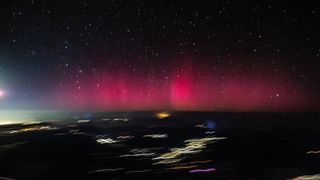Most powerful solar storm in 6 years caused auroras all over the US. And nobody saw it coming.
A severe geomagnetic storm from a huge hole in the sun's corona caused a massive disturbance in Earth's magnetic field. The surprise event sparked auroras as far south as Alabama and northern California.

The strongest solar storm to hit Earth for six years sparked stunning auroras across the U.S., with intense light displays appearing as far south as Alabama and Northern California. Yet no one saw it coming.
The March 24 solar storm was the result of a "stealth" coronal mass ejection (CME) – or a gargantuan, fast-moving blob of plasma and magnetic field released from the sun – Live Science’s sister site Space.com reports (opens in new tab). The CME came from a coronal hole wider than 20 Earths that was spewing out solar winds at speeds over 1.3 million mph (2.1 million km/h).
Tamitha Skov (opens in new tab), a U.S. space weather forecaster, told Space.com that no one saw the G4 storm coming because it was "nearly invisible." She said these stealth storms launch far slower than a typical CMEs that erupts, so are more difficult to observe.
The blob of particles smashed into Earth’s atmosphere early on March 24, compressing the planet’s magnetic field and triggering a geomagnetic storm. It was classified as a G4, or "severe" storm on the National Oceanic and Atmospheric Administration’s five-level scale. Impacts of a G4 storm (opens in new tab) include radio blackouts for several hours and navigation outages.
Storms can also push auroras being pushed to much lower latitudes than usual. Auroras, or Northern Lights, normally only appear at high latitudes near the North and South Poles, because Earth's magnetic field deflects electrons in solar wind toward the poles. But when a solar storm strikes, more charged particles collide with gases in the upper atmosphere, meaning the night light shows can appear closer to the equator.
(The following tweet contains profanity.)
Witnessed literally the most insane aurora of my life tonight in Fairbanks. This was unreal. pic.twitter.com/D3b6YNqX31March 24, 2023
That was the case for last night's stealth storm.
"Forecasters completely missed this one," a post on SpaceWeather.com (opens in new tab) said. "Auroras spread into the United States as far south as Colorado and New Mexico during a severe (category G4) geomagnetic storm — the most intense in nearly 6 years."
Video and images showing the phenomena were shared by onlookers, including photographer Dakota Snider, who captured images of pink aurora from a flight between Los Angeles and Phoenix.
Snider told Live Science in a message on social media that this was the first time he had seen auroras. Snider closely follows weather and rare events because he is a professional photographer.
"Before we took off I was thinking about how I might get the opportunity to see them from the air, but it would be a pretty far stretch if it was possible. Once we were up at elevation, you could see a faint glow, and I thought it was the lights." Snider said.
"Everyone was asleep on the plane except the flight attendants who were beyond stoked to see such a rare event this far south!"
Vincent Ledvina, an astrophotographer and graduate student at the University of Alaska Fairbanks Geophysical Institute also posted footage of the display. "Witnessed literally the most insane aurora of my life tonight in Fairbanks," he wrote on Twitter (opens in new tab). "This was unreal."
Generally, the stronger the geomagnetic storm, the further from the poles auroras can be seen. According to NASA’s Fermilab, in 1859 a solar flare caused auroras as far south as Cuba. The Carrington Event, as it is known, is considered the strongest geomagnetic storm in recorded history.
Editor's Note: This story was updated on Mar. 24 to correct Dakota Snider's pronouns.
Live Science newsletter
Stay up to date on the latest science news by signing up for our Essentials newsletter.

Hannah Osborne is the planet Earth and animals editor at Live Science. Prior to Live Science, she worked for several years at Newsweek as the science editor. Before this she was science editor at International Business Times U.K. Hannah holds a master's in journalism from Goldsmith's, University of London.
-
Giovani Reply
Humans are not perfect though the research of the sun should be. In the past ten years a number of surprises have been witnessed by this planet's scientists. The 2012 near miss of a major CME which would have caused serious problems for the denizens of earth, was one of several bullets dodged by humankind.admin said:A severe geomagnetic storm from a huge hole in the sun's corona caused a massive disturbance in Earth's magnetic field. The surprise event sparked auroras as far south as Alabama and northern California.
Most powerful solar storm in 6 years caused auroras all over the US. And nobody saw it coming. : Read more
Surprises are not good in this fashion. The reality is that at any time a "surprise" could alter this race due to a cosmic disaster. The geological and cosmic history of this planet seems to be rather quiet these eight thousand years. My opinion is that we are due to experience a cosmic upheaval at any time and it will be a surprise.
To think a tiny speck of an iron/nickel object a mere six miles in diameter impacted earth sixty-five million years ago and changed it forever. It's what we haven't identified yet that can be very close in reality. Surprise.
Most Popular

By Harry Baker